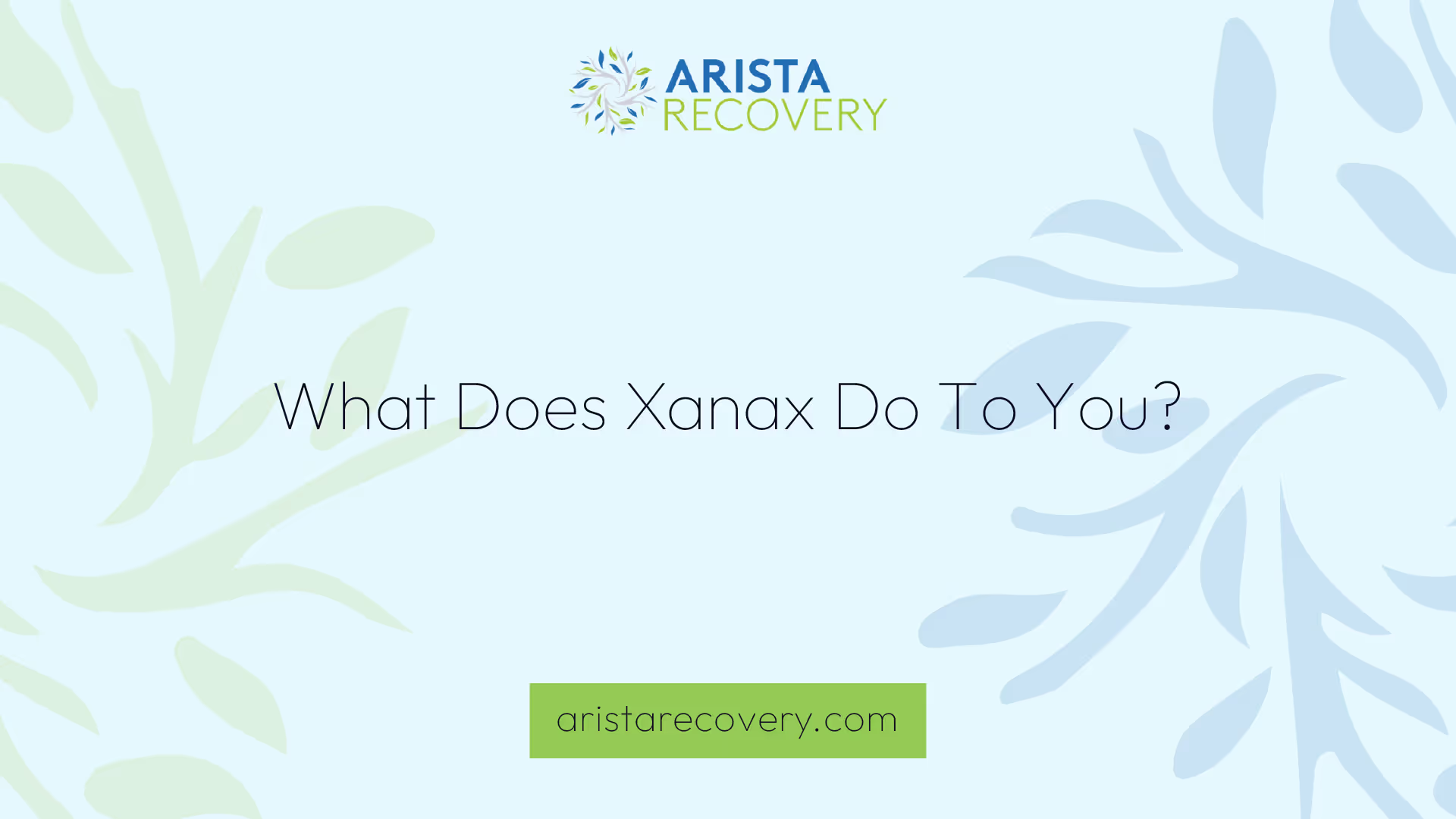What Does Xanax Do To You?

Understanding Xanax Addiction
Gaining insight into Xanax addiction begins with understanding its use and the potential for dependency. As a commonly prescribed medication, it's crucial to comprehend what Xanax does and how it can lead to dependency.

Introduction to Xanax Use
Xanax, with the generic name alprazolam, is frequently prescribed to treat conditions such as anxiety and panic disorders. It works by producing a calming effect on the brain and nerves through its action on the central nervous system. Specifically, Xanax enhances the effects of a natural chemical in the body called gamma-aminobutyric acid (GABA), which helps to calm the brain and nerves [1].
While Xanax can effectively manage anxiety and panic disorders, it's important to be aware of its potential side effects. These can include drowsiness, dizziness, increased saliva production, or changes in sex drive/ability.
Dependency on Xanax
Despite its therapeutic uses, Xanax can sometimes cause addiction, especially in individuals with a substance use disorder. It's essential to take this medication exactly as prescribed to lower the risk of addiction [1].
The risk of dependency increases with higher dosages and longer durations of use. When the body becomes accustomed to the presence of Xanax, sudden discontinuation may lead to withdrawal symptoms. This dependence is a clear indication of Xanax addiction.
Understanding the risks and potential for dependency associated with Xanax use is a crucial step in preventing addiction. As with any prescription medication, it's important to use Xanax responsibly and under the supervision of a healthcare professional. If you or a loved one are struggling with Xanax use, seek professional help immediately.
Impact on Behavior
Xanax can have significant impacts on behavior, particularly when misused or taken in higher doses than recommended. It's essential to understand these potential behavioral changes when considering the question, "what does Xanax do to you?"
Risky Behavior
Xanax addiction often leads to significant changes in an individual's behavior. The drive to obtain more Xanax can lead to risky and dangerous behavior. According to Phoenix Rising Recovery, individuals may become willing to do almost anything to secure more of the medication. This could involve illegal activities or behaviors that put the individual and others at risk.
Moreover, combining Xanax with other substances, such as opioids, alcohol, or stimulants, can lead to severe complications. These can range from respiratory depression and coma to death. Mixing substances can also mask or modify the effects of the drugs, potentially leading to an overdose.
Behavioral Changes
Xanax misuse can lead to other behavioral changes as well. These can take various forms, and they might include shifts in mood, changes in social activities, or alterations in personal relationships.
One of the most common effects of Xanax misuse is the development of physical dependence and tolerance. When this happens, an individual requires higher doses of the drug to achieve the same effect. This can lead to a cycle of increasing use and dependence, ultimately escalating the risk of addiction [3].
Furthermore, individuals misusing Xanax are at risk of experiencing withdrawal symptoms, which can occur just a few hours after the last dose. This can lead to further behavioral changes as the individual grapples with uncomfortable or even potentially dangerous withdrawal symptoms.
In conclusion, the impact of Xanax on behavior can be significant, particularly when the drug is misused or taken inappropriately. It's essential for individuals and their loved ones to be aware of these potential changes and to seek help if they notice signs of addiction or other negative effects.
Long-Term Effects of Xanax
Xanax, widely prescribed for its calming effect on the nervous system, can have significant long-term effects on both physical health and cognitive function. Understanding these impacts is crucial for individuals considering or currently using Xanax.
Physical Health Impacts
Long-term Xanax use can lead to severe damage within the body. According to Phoenix Rising Recovery, prolonged Xanax usage can result in physical damage to the kidneys and liver, irregular heartbeat rhythms, blood pressure problems, and respiratory issues.
Further, the American Addiction Centers emphasize that long-term use can also lead to physical dependence and tolerance, requiring higher doses to produce the same calming effect. This increases the risk of severe withdrawal symptoms, which can occur as early as a few hours after the last dose and may include seizures, potentially threatening to life.
Cognitive Effects
In addition to physical health impacts, long-term use of Xanax can lead to significant cognitive effects. According to Phoenix Rising Recovery, Xanax abuse or addiction can cause brain damage resulting in memory problems, cognitive impairment, and a shorter attention span. There's also potential for it to contribute to the development of dementia.
This highlights the severe impact of Xanax on brain function and cognition over time. It's crucial for individuals and families to be aware of these potential long-term effects when considering or managing Xanax use.
Understanding what Xanax does to the body and brain over time is crucial in making informed decisions about its use. It's essential for individuals and their families to consult with healthcare professionals to understand the potential risks and side effects fully. It's also important to remember that help and support are available for those dealing with Xanax dependency and addiction.
Xanax Mechanism of Action
To fully grasp the effects of Xanax, it's crucial to understand how it works on a biological level. This section will delve into the mechanism of action of Xanax and its impact on the central nervous system.
How Xanax Works
Xanax, with the generic name alprazolam, is a medication commonly prescribed to treat conditions such as anxiety and panic disorders. It produces a calming effect on the brain and nerves by enhancing the effects of a natural chemical in the body called gamma-aminobutyric acid, or GABA.
GABA is an inhibitory neurotransmitter, meaning it reduces neuron activity in the brain. When Xanax enhances the effects of GABA, it results in the slowing down of the brain's functions. This leads to feelings of relaxation and calmness, reducing the symptoms of anxiety and panic disorders.
Effects on the Central Nervous System
As a benzodiazepine and central nervous system depressant, Xanax has a significant impact on the central nervous system (CNS). By enhancing the effects of GABA, it decreases brain activity, leading to a reduction in anxiety, tension, and fear.
While Xanax can be beneficial in treating anxiety and panic disorders, it's important to note that misuse can lead to adverse effects. The calming properties of Xanax, which are useful in treating anxiety, can become harmful when the drug is used inappropriately or taken in large doses. In 2020, 4.7 million people aged 12 or older misused prescription benzodiazepines, with 3.4 million misusing alprazolam in the past year [3].
Misuse of Xanax can slow down the CNS to a dangerous level, leading to impaired thinking, judgment, and coordination. It can also cause mood swings, depression, and in severe cases, unconsciousness or death. This highlights the importance of using Xanax only under the supervision of a healthcare professional and strictly adhering to the prescribed dosage.
Understanding how Xanax works and its effects on the CNS can help individuals and families impacted by substance abuse comprehend the risks involved and seek appropriate help when needed.
Risks and Side Effects
The use of Xanax, like any drug, carries potential risks and side effects. Understanding these repercussions can help one make an informed decision about its use and provide necessary precautions to manage the risks.
Potential Side Effects
The side effects of Xanax range from mild to severe, with some requiring immediate medical attention. Among the most common side effects are drowsiness, dizziness, and increased saliva production, according to Health Canada. In some cases, there may be an alteration in sex drive or ability.
More serious side effects may occur as well. These include but are not limited to unusual muscle movements, changes in mood or behavior, confusion, hallucinations, seizures, and thoughts about suicide, as pointed out by Drugs.com. Furthermore, some individuals may experience mental or mood changes, trouble speaking, loss of coordination, trouble walking, memory problems, yellowing of eyes or skin, seizures, and allergic reactions as listed on WebMD.
The table below summarizes some of the potential side effects of Xanax:
It's crucial to immediately seek medical help if any of these severe symptoms occur.
Withdrawal Symptoms
Abrupt discontinuation of Xanax, especially after prolonged use, can lead to withdrawal symptoms. The severity of these symptoms can vary based on the duration of use and dosage. These may include restlessness, anxiety, and trouble sleeping. In more severe cases, withdrawal can result in seizures, which can be life-threatening.
People experiencing withdrawal symptoms should seek immediate medical attention. It's advised to slowly reduce the dosage under the supervision of a healthcare provider rather than abruptly stopping the medication. This can help mitigate withdrawal symptoms and ensure a safer transition away from the medication.
Overall, understanding these risks and side effects can help individuals better evaluate the impact of Xanax on their health. It's crucial to consult with a healthcare provider before starting or stopping any medication, including Xanax.
Xanax Interactions
The effects of Xanax on the body can be significantly altered when combined with other substances, potentially leading to dangerous health risks. This section outlines the interactions of Xanax with two common substances: alcohol and opioids.
Alcohol Interaction
Combining Xanax with alcohol can lead to serious side effects. This is due to the fact that both substances are central nervous system depressants, which can result in symptoms like slowed breathing, extreme sleepiness, coma, or even fatality. Furthermore, combining alcohol with Xanax can increase the risk of Xanax misuse, potentially leading to overdose and life-threatening situations [5].
Additionally, according to the American Addiction Centers, combining benzodiazepines like Xanax with substances like alcohol can indirectly or directly increase the risk of severe complications like respiratory depression, coma, and death. Mixing Xanax with stimulants can mask or modify the effects of the substances, potentially leading to overdose.
Opioid Interaction
Similar to alcohol, Xanax also interacts with opioids, causing central nervous system depression. This can result in serious side effects like slowed breathing or extreme sleepiness. This interaction can raise the risk of coma or fatality. Doctors typically avoid prescribing opioids with Xanax unless other medications have been ineffective, and if prescribed together, close monitoring is necessary.
Alprazolam, the active ingredient in Xanax, can interact dangerously with opioid pain medications, leading to severe side effects like drowsiness and slowed breathing. The FDA has issued a boxed warning against the combination of alprazolam and opioids, recommending their use together only when safer combinations have been unsuccessful.
The American Addiction Centers also note that Xanax overdose, especially with high-dose misuse, can be dangerous. Symptoms of benzodiazepine overdose include respiratory depression, slowed breathing, respiratory arrest, and death. Mixing Xanax with other substances, particularly opioids and alcohol, significantly increases the risk of overdose.
In conclusion, individuals using Xanax should be aware of its potential interactions with other substances. Combining Xanax with alcohol or opioids can lead to serious health risks and should be avoided unless under the close supervision of a healthcare provider. The dangers of these interactions underline the importance of using Xanax responsibly and as prescribed.
References
[1]: https://www.webmd.com/drugs/2/drug-9824/xanax-oral/details
[2]: https://www.canada.ca/en/health-canada/services/substance-use/get-help-with-substance-use.html
[3]: https://americanaddictioncenters.org/xanax-treatment/long-term-severe
[4]: https://www.drugs.com/xanax.html
[5]: https://www.healthline.com/health/drugs/xanax-interactions
You’re not alone in this.
When mental health challenges and addiction intersect, it can feel isolating. At Arista, we offer compassionate, evidence-based, and trauma-informed care to help you heal, grow, and move forward.
You’re not alone in this.
When mental health challenges and addiction intersect, it can feel isolating. At Arista, we offer compassionate, evidence-based, and trauma-informed care to help you heal, grow, and move forward.
Support that moves with you.
You’ve taken a brave first step. At Arista Recovery, we’re here to help you continue with best-in-class care designed for long-term healing and support.
.webp)






